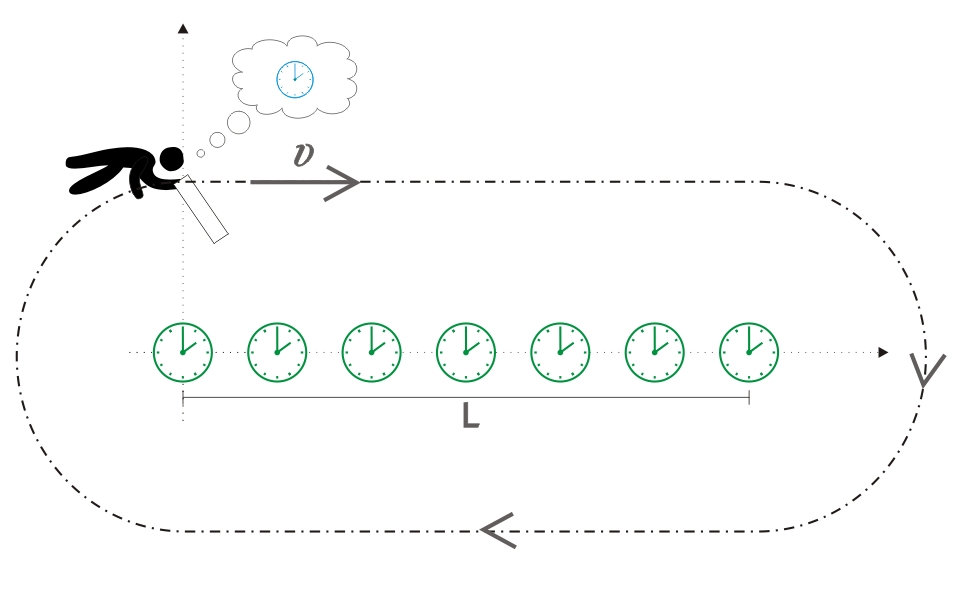Let’s long LED lamp is placed along an embankment. We can imagine, that each diode of that long LED lamp is a clock. All these clocks are Einstein – synchronized (one-way speed of light is c) and flash simultaneously in the Embankment’s frame.
An observer in a train car is moving along the Embankment and sees these diodes – clocks successively, in immediate vicinity.
It should be noted, that what clock rate the observer will measure, depends on how he measures it.


We can demonstrate time dilation of the SR in the following experiment (Fig. 1). Moving with velocity $v$ clocks measure time $t'$. The clock passes past point $x_{1}$ at moment of time $t_{1}$ and passing past point $x_{2}$ at moment of time $t_{2}$.
At these moments, the positions of the hands of the moving clock and the corresponding fixed clock next to it are compared.
Let the arrows of moving clocks measure the time interval $\tau _ {0}$ during the movement from the point $x_ {1}$ to the point $x_ {2}$ and the hands of clocks 1 and 2, previously synchronized in the fixed or “rest” frame $S$, will measure the time interval $\tau$. This way,
$$\tau '=\tau _{0} =t'_{2} -t'_{1},$$
$$\tau =t_{2} -t_{1} \quad (1)$$
But according to the inverse Lorentz transformations we have
$$t_{2} -t_{1} ={(t'_{2} -t'_{1} )+{v\over c^{2} } (x'_{2} -x'_{1} )\over \sqrt{1-v^{2} /c^{2} } } \quad (2)$$
Substituting (1) into (2) and noting that the moving clock is always at the same point in the moving reference frame $S'$, that is,
$$x'_{1} =x'_{2} \quad (3)$$
We obtain
$$\tau ={\tau _{0} \over \sqrt{1-v^{2} /c^{2} } } ,\qquad (t_{0} =\tau ') \quad (4) $$
This formula means that the time interval measured by the fixed clocks is greater than the time interval measured by the single moving clock. This means that the moving clock lags behind the fixed ones, that is, it slows down.
However, time in reference frame from the “point of view of the single clock” is running $\gamma$ times faster instead.
This way we can see, that if moving observer compares his clock readings successively with synchronized clocks of reference frame he moves in, he will see, that these clocks change readings $\gamma$ times faster.
However, if the observer changes frame and places two spatially separated clocks of his frame $S'$ at points $x'_{1}$ and $x'_{2}$ then every single diode that moves from $x'_{1}$ to $x'_{2}$ will flash $\gamma$ times slower.
The animation below vividly demonstrates that:

Small note in regard of Transverse Doppler effect (diagram is below). Transverse Doppler effect reflects rate of clock. We can imagine, that observer moves along the row of clocks and looks at these clocks through a telescope. Let all clockfaces of these clock are highlighted in green monochromatic light.
What color of the clocks the observer will see? If he think, that he is at rest, he will direct his tube at right angle to the line that connects clocks (long LED lamp). Then he will see, that clock rate of every single clock is $\gamma$ times slower. Color of each clockface will be red, or $\gamma$ times redshifted. However, during reversal, when he moves at half – circle around the last clock, he will not see any light, because he annot acribe himself state of rest then. Due to aberration, he must always keep his telescope at angle $\sin \alpha = v/c$
He must remember, that he himself moves in the reference frame of the LED lamp. He must take aberration into account and turn his telescope forward at relativistic aberration angle $\sin \alpha = v/c$. He will always, all the time will see clocks and each clock will be of blue color, or $\gamma$ times BLUESHIFTED due to Transverse Doppler effect. This way he will see, that each individual clock is ticking $\gamma$ times faster, since his own clock dilates, and the set of clocks, if he looks at them successively, runs faster. He can explain that by dilation of his own clock, since he moves himself in the reference frame $S$.
Actually it is Twin paradox, simply explained, no acceleration involved. Don't change frame and there is no paradox.
See Transverse Doppler Effect in Wikipedia.
 Transverse Doppler blueshift comes out straight from the Einstein’s 1905 paper, chapter 7.
Transverse Doppler blueshift comes out straight from the Einstein’s 1905 paper, chapter 7.
Einstein gives this Doppler shift formula for moving observer:
$$f_0= \frac {(1+\cos\theta_s\cdot v/c)}{\sqrt {1-v^2/c^2}}f_s(2)$$
That means that moving observer sees increase of source's clock rate, since square root resides in denominator.
If source emits at right angle in its frame ($\cos\theta_s = 0$) frequency will be $\gamma$ times blueshifted.
Observer who makes U - turn around the source will always see blueshift of frequency, i.e. that source's clock is running faster. Source always emits at right angle. He cannot see any other frequency shift, only blue one.
Actually, an observer in $S'$ can measure higher rate of a single clock of $S$ by means of two spatially separated clocks at points $x'_{1}$ and $x'_{2}$, but he must synchronize these clocks by Reichenbach, not Einstein, or simple take time of reference frame $S$. One - way speed of light measured with these clocks will be different from c, though speed of light back and forth (round trip, measured with single clock) will still be c. Then single moving clock of $S$ will appear ticking $\gamma$ times faster than two clocks at $x'_{1}$ and $x'_{2}$.





